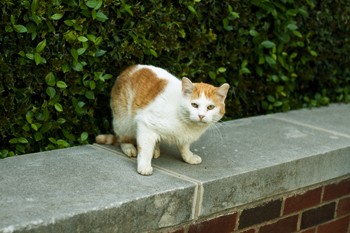
A feral cat sits outside of the Cox School of Business Tuesday evening. Beds with the words “SMU Feral Cat Project” can be seen nearby in plant beds. (Casey Lee)
Cori Cusker got her first cat when she was five years old, and since then has been an avid animal lover. But when she and her husband, Robert May, moved into on-campus housing in 2007 they had to give their four cats to family and friends. To fill the void, Cusker and May spend each Friday night biking and walking through campus, feeding the feral cat population.
“It’s time that we get to spend together, and it’s time that we get to spend with animals,” Cusker, Boaz residence hall director, said.
Cusker and May are two of 16 faculty, student and community volunteers for the SMU Feral Cat Program. The program, officially supported by the Office of the President and the Office of Legal Affairs, is meant to humanely control the feral cat population on campus and feed them each night.
“We’ve got about 18 different stops from one end of campus to the other, from Dedman Life Sciences to the Meadows Museums, to the Central Expressway retaining wall,” program coordinator and English professor Jacqueline Bradley said.
Bradley, who started taking care of the feral cats five years ago, estimates the current feral cat population to be about 50, down from 90 when she started. According to Alley Cat Allies, a national organization promoting the care of cats, there are an estimated 82 million feral cats nationwide. These cats are either born in the wild or are house cats that have learned to live on their own.
“Any place where you have a transient population – apartment complexes, military bases and universities – is notorious for having feral cat colonies, because you have people that abandon their pets,” Bradley said.
Homeless cats, specifically, are not uncommon to local residents.
“They’re seen just as often as you see squirrels,” said sophomore Courtney O’Callaghan, who lives near Airline Road and Rosedale Avenue.
A white cat covered in pink spray paint roams the neighborhood, trying to get into houses and apartments, she said.
“You do feel sorry for them,” O’Callaghan said, “but you know it’s very common.”
Part of the reason for the abundance of cats in the area is the absence of a leash law, City of University Park Animal Control Officer Launa Patton said.
“Cats that are roaming are not necessarily picked up,” Patton said, “unless they are a nuisance.”
According to Bradley, the problem is that most people who abandon their cats do not spay or neuter their cats.
“So then you get generations of litters that are not raised in a home,” Bradley said. “They’re outside, they become feral, they become unapproachable by humans, and they become little wild cats.”
Controlling this growing population is where programs, like SMU’s, come into play, Bradley said. Volunteers trap the feral cats and take them to KittiCo, a non-profit organization working with the city of Dallas, where they are spay/neutered and vaccinated. The tips of the cats’ left ears are also chopped off, indicating that they’re part of a feral cat colony. The cats are then released into their campus habitats. This process is known as TNR, or trap, neuter, release.
“It’s not that we don’t want the cats here. The cats have a place in our ecosystem,” Bradley said. “For example, we would be overrun with rodents if we didn’t have these cats. But you’ll never see a rat on campus, because we have the cats on campus who take care of that problem.”
According to Patton, University Park, which borders most of campus, has had a history of rodent problems. Bradley, who has been on the SMU campus for 20 years, says she’s never seen a rodent.
Although the cats help maintain the campus, for many volunteers it is really about helping the cats.
“I think, even though they’re feral, they deserve the care and attention just as much as a house cat,” Cusker said.
This desire to help animals is something the Summerlee Foundation, which provides the program with a grant, deems admirable.
“Cats are of particular interest to us because we feel that they don’t get the attention they deserve,” Summerlee Animal Protection Program Director Melanie Lambert said. “The reason we liked the SMU program was because everyone was involved, from the administration, to the faculty, to the students.”
Lambert said programs like SMU’s help cats avoid shelters where they could be euthanized. According to Patton, the City of University Park Animal Control supports TNR, but in some cases feral cats are euthanized. Patton, who took a feral cat that faced extermination home with her, said “very few” cats have been euthanized in the past year.
Bradley and Cusker have also lost a few cats. During the demolition of Caruth Hall this past fall, a cat named Kiran disappeared, and Muki was run over on SMU Boulevard in January. The volunteers name each cat to keep track of them.
“It’s just like learning the names and faces of your friends really,” Cusker said. “You have regular customers at each of your feeding stops, and it’s just memorizing.”
Although Cusker still owns her house cats, feeding the feral cats every Friday night gives her the animal connection she can’t get living in the dorm.
“Just being around animals and feeling like I am doing something for them makes me feel better,” Cusker said. “Just seeing them lifts my mood a little bit.”








